Climate scientists normally are wary of associating daily weather events to longer term climate change, but new research does just that by showing that daily record high temperatures across the continental U.S. occurred twice as often as record lows over the last decade.
"Climate change is making itself felt in terms of day-to-day weather," Gerald Meehl, a researcher at the National Center for Atmospheric Research, said in a statement announcing the research. "The ways these records are being broken show how our climate is already shifting."
Moreover, that 2:1 ratio is likely to increase dramatically if greenhouse gas emissions keep rising, the experts said.
From Jan. 1, 2000, to Sept. 30, 2009, the continental U.S. saw 291,237 record highs and 142,420 record lows — reflecting a decade of unusually mild winter weather and intense summer heat waves.
Even in the first nine months of 2009, when U.S. temperatures cooled after several unusually warm years, the high-to-low ratio was still more than 3:2.
'Odds are shifting'
Meehl, the study's lead author, emphasized that record cold days will still happen.
"One of the messages of this study is, you still get cold days," he said. "Winter still comes. Even in a much warmer climate, we're setting record low minimum temperatures on a few days each year. But the odds are shifting so there's a much better chance of daily record highs instead of lows."
Data from thousands of weather stations was used, going back six decades to capture longer-term trends.
Since record lows often are set at night, the researchers noted, the fact that those lows were fewer than in previous decades shows that much of the nation's warming is occurring at night.
That finding is consistent with computer models showing that higher overnight lows should be expected with climate change.
50-to-1 ratio seen as possible
The team also used computer modeling to estimate high-to-low ratios into the future.
If greenhouse gases keep rising at their current trend, the U.S. ratios could increase to 20-to-1 by mid-century and 50-to-1 by 2100, the experts calculated.
If temperatures were not warming, the number of record daily highs and lows being set each year would be approximately even, the researchers found.
"If the climate weren't changing, you would expect the number of temperature records to diminish significantly over time," said Claudia Tebaldi, a statistician with Climate Central and a study co-author.
"As you measure the high and low daily temperatures each year, it normally becomes more difficult to break a record after a number of years," she added. "But as the average temperatures continue to rise this century, we will keep setting more record highs."
The study — by authors at NCAR, Climate Central, The Weather Channel and the National Oceanic and Atmospheric Administration — has been accepted for publication in the peer-reviewed Geophysical Research Letters.
It was funded by the National Science Foundation and by the Department of Energy and Climate Central, which is a nonprofit group that works with scientists to explain climate issues to the public.
